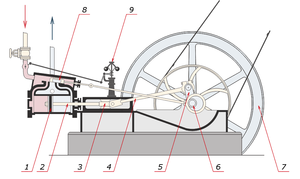Reciprocating engine
This position is also known as the bottom dead center (BDC), or where the piston forms the largest volume in the cylinder.A flywheel is often used to ensure smooth rotation or to store energy to carry the engine through an un-powered part of the cycle.These are rings made of a hard metal, and are sprung into a circular groove in the piston head.The rings fit closely in the groove and press lightly against the cylinder wall to form a seal, and more heavily when higher combustion pressure moves around to their inner surfaces.For example, for internal combustion engines, single and two-cylinder designs are common in smaller vehicles such as motorcycles, while automobiles typically have between four and eight, and locomotives and ships may have a dozen cylinders or more.Opposed-piston engines put two pistons working at opposite ends of the same cylinder and this has been extended into triangular arrangements such as the Napier Deltic.Therefore: Whichever engine with the larger value of MEP produces more net work per cycle and performs more efficiently.Internal combustion engines operate through a sequence of strokes that admit and remove gases to and from the cylinder.These operations are repeated cyclically and an engine is said to be 2-stroke, 4-stroke or 6-stroke depending on the number of strokes it takes to complete a cycle.[8] Torpedoes may use a working gas produced by high test peroxide or Otto fuel II, which pressurize without combustion.The 230 kg (510 lb) Mark 46 torpedo, for example, can travel 11 km (6.8 mi) underwater at 74 km/h (46 mph) fuelled by Otto fuel without oxidant.Quantum refrigerators are devices that consume power with the purpose to pump heat from a cold to a hot reservoir.A theoretical study has shown that it is possible and practical to build a reciprocating engine that is composed of a single oscillating atom.
- C. Crankshaft
- E. Exhaust camshaft
- I. Intake camshaft
- P. Piston
- R. Connecting rod
- S. Spark plug
- W. Water jacket for coolant flow
- V. Valves


A labeled schematic diagram of a typical single-cylinder, simple expansion, double-acting high pressure steam engine. Power takeoff from the engine is by way of a belt.
- Piston
- Piston rod
- Crosshead bearing
- Connecting rod
- Crank
- Eccentric valve motion
- Flywheel
- Sliding valve
- Centrifugal governor

- Hot cylinder wall
- Cold cylinder wall
- Displacer piston
- Power piston
- Flywheels
Pneumatic motorHydraulic motorfour-stroke cyclegasolineCrankshaftcamshaftPistonConnecting rodSpark plugValvesheat enginereciprocatingpistonspressurerotating motioninternal combustion enginemotor vehiclessteam engineIndustrial RevolutionStirling enginespark-ignition (SI) enginecompression-ignition (CI) enginethus heating itearliercylinderignitiondead centerflywheelexhaustedstrokeswashplatepiston ringsdisplacementlitresmotorcyclesautomobileslocomotivescompression ratiobore/stroke ratioin lineV configurationhorizontally oppositeradiallyOpposed-piston enginesNapier Delticrotary engineRhombic Drivecompound enginesD slide valvepiston valvepoppet valvecutofftorqueoscillating cylinder2-stroke4-stroke6-strokeHistory of the steam engineHistory of the internal combustion engineatmospheric enginepetroldieselliquefied petroleum gascompressed natural gasengine power plantsPratt & Whitney R-4360 Wasp Majorpower-to-weight ratioWärtsilä-Sulzer RTA96-CWärtsiläEmma Mærskmetric tonsshort tonslong tonsengine displacementspecific powerhorsepowerfuel efficiencysteam turbineshigh test peroxideOtto fuel IIMark 46 torpedooxidantQuantum heat enginesquantum mechanicsQuantum refrigeratorsCarnot cycleOtto cyclethermodynamicsendoreversible thermodynamicsnanotechnologyBourke engineFree-piston engineIRIS engineOpposed-piston engineAxial engineCam engineRevolving cylinder engineSwing-piston engineThermo-magnetic motorpistonless rotary engineTimeline of heat engine technologySteam locomotiveDiesel cycleEngine configurationDiesel engineGasoline engineOil field engineEngine configurationspiston enginesAtmosphericCornishRotativeBourkeCamlessCompoundDouble-acting cylinderFlatheadFree-pistonStelzerHeron headIntake over exhaustOpposed-pistonOverhead camshaftOverhead valvePentroofRotary